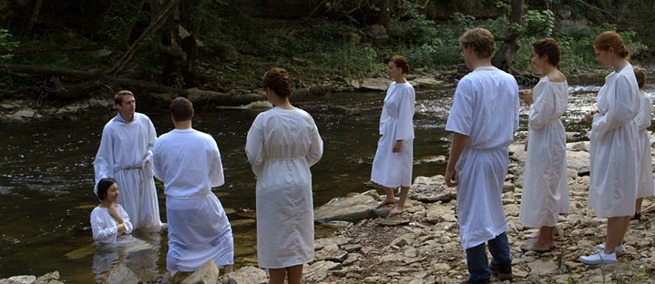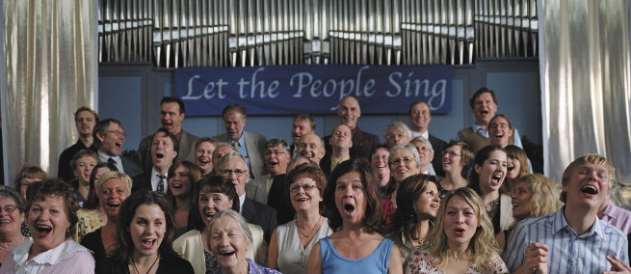
As It Is in Heaven, the debut film by writer/director Joshua Overbay that’s currently self-distributing around the country, is in every way a sensitive and expertly executed art-indie in the Martha Marcy May Marlene mold. It’s lyrical and ominous and observational in ways that are sharply engaged with American subculture. It’s also about a doomsday cult.
This presents secular, educated viewers, with a problem right after launch: Who are these people? Overbay sees the tension, and does a delicate rain dance around it—his small cadre of Lord lovers, nestled in an expansive estate house deep in the Kentucky wilderness, are wide-eyed pilgrims, their hands and Bibles raised to the sky, their faces beaming with loving hope. They are counting down to the Rapture—how their leader has calculated this is elided—and suffer a crisis within their community when the old man kicks it and a young novice takes over, imposing a deadly fast and inciting dissension. Then the clock ticks down, in a field full of white robes…
Overbay does not mock or demonize these people; they are sincere and pious and sweet. But he does manage to impose a creeping sense of disjuncture, of deranged disconnection, into the proceedings, merely by way of smart casting (many of the cult’s supporting members have remarkable faces that suggest child-like personalities silently and catastrophically traumatized by life) and patiently observing these people doing what they do, which is little more than preach and pray incessantly, as though they’re compulsively trying to convince themselves of their own delusion.
But could that be me, reading into this Rorschach of a situation? How is a secularist supposed to handle movie characters of intense faith? Are millenarians just people, too? Are they devoting their lives to a sci-fi fantasy story about God and heaven and clean souls, and does that make them mad? (We know their harebrained prophecies are always wrong, as one cult rising after another has seen its doomsday come and go, leaving them to mope home and formulate rationalizations.) In the everyday quotidian, the secular atheists among us (according to a BBC poll, non-religious Americans make up 15% of the population, a figure that rivals the entire Hispanic demographic) confront feverish, committed religiosity all the time, and as a matter of social management we shrug it off, consider it all a matter of “faith” and so therefore a personal, emotional line item with which we must not necessarily judge or assess the individual in question. A neighbor or co-worker who shares apocalyptic ardor and Fatherly communion over weekly Bible meetings is regarded politely, if distantly, as long as the conversation stays neutral.
We don’t, in a word, think they’re insane. (We can’t only because their terrifying conclusions are part of a socially institutionalized mythology; if a friend confided with an earnest gaze that he or she knew that Sauron was going to demolish America with an infinite army of orcs next week, you’d have just cause to raise a red flag and help get the slob some treatment.) On film, where following a narrative means attempting to understand characters both as individuals with motives and as figures in a contrived landscape all invented by the filmmaker for this or that thematic purpose, it’s a different story. We’re confronted with a human enigma—the Pentecostal or jihadi or Jonestown minion—and how we personally feel about God and the Rapture and heaven cannot help but define our response to the characters, and therefore restrict our reading of the film. In As It Is in Heaven, the paradigmatic story the cult members tell themselves, about being one with the Father on a certain day, sounds to my ears like fairy-tale madness, and for me it’s a film about group lunacy. Someone else, maybe even someone touched just a little by religious feeling, might see a completely different film.

The varieties of religious experience have undergone a few major shifts in cinema, from stories told from an orthodox Church perspective, often involving saints and messiahs and the voice of God, none of it meant to be ambiguous in the least, to the postmodern era perhaps beginning with Robert Bresson’s Diary of a Country Priest (1950), in which faith was a crucible of doubt and struggle, a dynamic secular atheists could get down with easily enough. The way Joan of Arc has been treated in movies—from the holy political victim of Carl Dreyer’s very sacred La passion de Jeanne d’Arc (1928) to the raving teen fanatic of Otto Preminger’s Shaw adaptation Saint Joan (1957) to the full-on hallucinating maniac of Luc Besson’s The Messenger (1999)—always leaves us with a margin of madness to consider. Robert Duvall’s The Apostle (1997) is an exception, not unlike Overbay’s film in its lack of judgment of its compromised evangelist hero and his flock, but certainly more expressive of American evangelism as a kind of. interactive carny showbiz that’s as entertaining as it is fantastical.
Cults, because they are self-governing and secret and based on radical ideas we don’t all share, are unsettling, even if, as in the case of the Branch Davidians, nothing more unsavory or unusual than prayerful daydreams and weapons caching is going on. Movies usually take a suspicious view, less for normative reasons than due to the influence of the viewer. Movie characters aren’t just people; they are concoctions, built for a purpose, be it thrill-making or truth or hilarity or empathic insight, and we have to have a firm, if sometimes flexible, idea of who they are in order for the film to resonate. Committed millenarian thinking is so close to psychosis in every practical way that, if it’s depicted without editorial slant, it leaves us unmoored. It may be the most fascinating and haunting strand of American life in the last century, but as a cinematic subject, it may be too slippery, too evasive, to tackle.